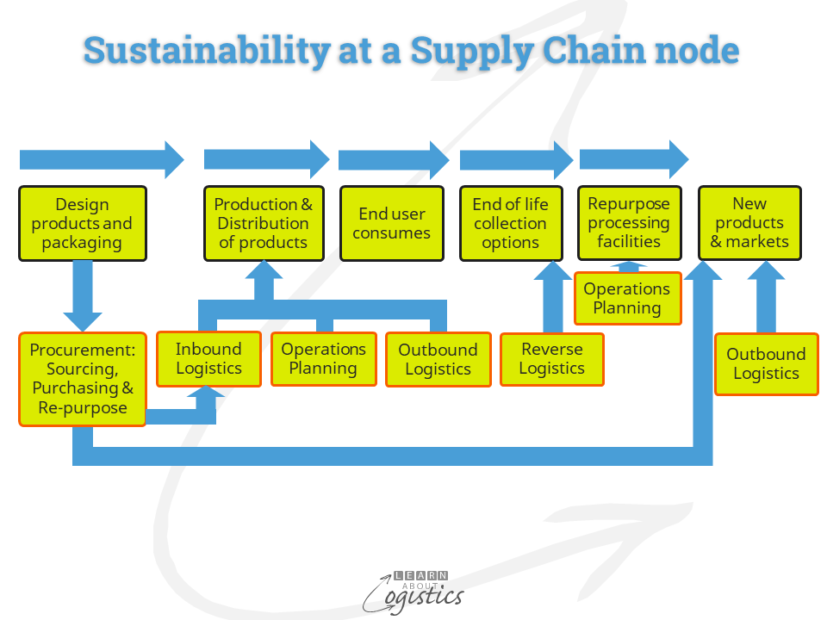Changing role of Procurement
The world is experiencing changing times and a return to ‘normal’ is unlikely. Nations, communities and companies will need to review and even change their economic or business model. For commercial companies that add value to purchased goods and services, the responsibility for the revised relationships with suppliers will fall on Procurement
The focus of Procurement cannot be just about achieving ‘value’ (however measured) from suppliers. The role must become one of managing risks through an organisation’s Supply Chains Network. That is, ensure supply chains are sustainable for the future and have resilience against threats and for the business, protect its competitive position and reputation.
Learn About Logistics has updated the definition of Procurement to: An integrated sourcing and purchasing process, linked to the business strategy of an organisation; whereby the needs of the organisation are met effectively and efficiently by suppliers at the lowest total cost of ownership (TCO). This includes environmental, social and governance (ESG) factors, that maintain a sustainable competitive position, while benefiting suppliers and their stakeholders
This means that in addition to considering the immediate business priorities of purchases, the Procurement process must identify and manage the risks associated with ESG – for example, the use (and possible destruction) of natural resources, instances of modern slavery and potential corruption in supply chains.
Measuring Sustainable Procurement
In some articles discussing ESG, there is concern about the lack of standard performance metrics and the methodology for measurement. Attempting to achieve accuracy of measurement to four decimal places will not fix the problems. For Procurement, the approach driven by climate change is to initially recognise there are multiple challenges with continuing supply that must be addressed in a short period of time.
Obtaining supply at the lowest buy price is of little comfort if the items arrive late and on arrival are rejected by QA! The major challenge for Procurement is to change the accounting mindset that achieving continual cost-down is the objective of Procurement. It is not, as shown in the definition above. Achieving the lowest Total Cost of Ownership (TCO) that includes ESG factors is not a one-off exercise, but an ongoing, continuous improvement program with tier1 (and hopefully tier 2) suppliers.
To commence the incorporation of ESG factors into business relationships, elements of a more general nature can be incorporated into revised and new supply contracts, such as:
- Compliance with environmental laws and regulations
- Not to use or identification of conflict minerals in supplied items
- Not to use or identification where child labour and modern slavery are used in supply chains
As the programs develop, metrics can be devised that assesses ESG practices of the business that influence its suppliers; also ESG understanding and practices at tier1 suppliers and contractors. As there is little time until 2030, the urgency is for the Supply Chain group to get the TCO program approved by senior management (and possibly the board of directors) and then plan the program with the most willing tier1 suppliers.
Organisations are generally not as knowledgeable about their Supply Chains Network as they may imagine, particularly concerning country and location risks. Also the risks associated with third-party production and distribution contractors – the operation may be outsourced but the risks are not. A previous blogpost also noted that obtaining data directly from suppliers may not be an easy task, so Procurement must plan its data gathering for Supply Markets Intelligence.
From Disposal to Re-purpose
The typical approach of Procurement is concerned about the sourcing and purchasing aspects of items to meet the needs of internal users. Except in the case of buying capital equipment, rarely is there any consideration of what happens to products or materials once they reach the ‘end of life’ stage. Even in capital purchases, the Disposal stage is considered as being far into the future, so not given to detailed analysis.

Sustainable Procurement, also called ‘Circular Procurement’ requires that Procurement professionals change their focus from the linear ‘Take: Make: Dispose’, to extending the lifespan of the item through Re-purposing items and materials. The diagram illustrates this thinking. At the start, consider the materials proposed for a product. For each, identify the Re-purpose actions for the product or materials at ‘end of life’, which could be the packaging thrown away by a consumer within hours of purchase.
For ‘hard’ goods, Repair will take on a new dimension when EU regulations concerning the ‘right to repair’ becomes effective. This will require products to be repairable, have repair manuals available and brand companies to hold service spares for 10 years. For product Returns and Recalls and products at their ‘end of life, they will be evaluated for Refurbishment or Re-manufacture and if not a viable proposition (using life-cycle costing methods) decide how the materials in products be Recycled to ensure the minimum of finite resources are consumed.
When ‘identifying the need’ at the start of the Procurement process, there must be an understanding concerning how a product will be Re-purposed through its lifecycle. Specifications can then be be structured for Procurement to approach suitable suppliers.
TCO approach
The TCO approach is to evaluate the possible ‘unintended consequences’ of the focus on a narrow outcome e.g. buying a component part. This is to reduce the internal risk of false economy, such as when an action is assumed to save money, but over time, more money is spent in other areas than was ‘saved’. Also, an action which adds to costs is considered a ‘waste’, although the risks (and cost) of not taking the action are higher in other areas.
TCO requires some insight into the ‘why’ and ‘how’ and conditions of the current processes. As always with potentially large projects, start the TCO journey in small steps, especially in complex supply chains. Experience by Learn About Logistics is to ask the front-line people in your business about their views concerning critical purchased items and the associated ordering and receiving processes.
As there will be improvements required on both sides, discussing the results of staff meetings with tier 1 suppliers is a good beginning to a better relationship. The discussion can then be developed into longer term and broader issues concerning ESG factors that are pertinent to the relationship. This is likely to require differing perspectives and therefore involvement of disciplines across the organisations, with the process facilitated by Procurement.

